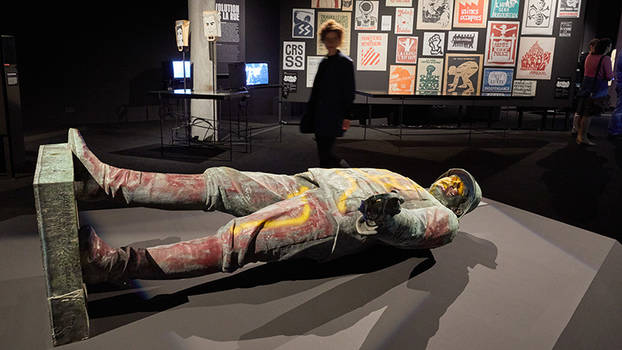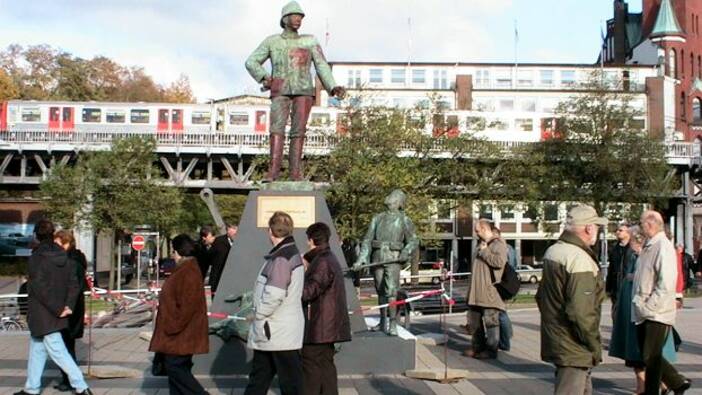
Recent pushback against structural and institutional racism has given rise to a sense of societal awakening. The focal points of the Black Lives Matter movement have been the protests, which have attracted a great deal of publicity, and the toppling of statues and monuments to colonial figures. For example, in Richmond, Virginia, demonstrators brought down a statue of Christopher Columbus and hurled it into a nearby lake. In the English city of Bristol, the statue of slave trader Edward Colston was removed from its plinth and plunged into the River Avon. In Ghent, Belgium, protesters smeared red paint over a bust of the Belgian King and “Butcher of the Congo” Leopold II. In many other places, as well, there have been anti-colonial attacks and monuments have been felled.
Andreas Bohne is an Africa scholar and works as a political advisor at the Berliner Entwicklungspolitischen Ratschlag. He has been active for many years in postcolonial initiatives such as Völkermord verjährt nicht! Translated by Louise Pain for Gegensatz Translation Collective.
Different, But Not New
Within this context, the discussion about the pervasiveness of colonial traces in public spaces has also regained momentum in Germany. While the anti-colonial activities of recent years have primarily focussed on colonial, racist street names and the push to rename or else contextualize them, other symbols are now also increasingly becoming the subject of scrutiny. However, there are three aspects that are often overlooked in these debates and actions.
First, the toppling of colonial monuments is not a new phenomenon. The fall of the memorial to Hermann von Wissmann in Hamburg in 1968 is a great example: students from the University of Hamburg fastened ropes around the statue and pulled it down. However, unlike the most recent case in Bristol, Wissmann did not end up in the Elbe, but instead was safely stored away. And, unlike today’s cases, the toppling of the Wissmann statue was initiated and carried out by a small group of activists. In contrast, the post-colonial and decolonial discussions of recent years are currently unfolding their mobilizing and politicizing effect: the movement has broadened significantly.
Secondly, the current focus on colonial monuments in Brussels, London, Bristol, and other European cities often occludes the demolition and re-designation of monuments in African countries. The physical location of colonial monuments in Africa means that they represent European claims to power, supposed “civilizing missions”, and the violent subjugation of local communities. It is no wonder then that monuments of this kind that “commemorate the victors” have often been taken down in African countries. After Zimbabwe gained independence in 1980, a statue of Cecil Rhodes was taken down and replaced with a new monument to the unity of Africa. In 2015, unknown individuals decapitated a statue of Queen Victoria in Nairobi, Kenya. Decades ago in Kinshasa, the capital of the Democratic Republic of the Congo, a statue in honour of the “colonial master” King Leopold II of Belgium was pulled down—a copy of the same statue that is today at the centre of demonstrations in Belgium. The statue had been erected in 1928, and the dictator Mobutu Sese Seko had it demolished seven years after the country achieved independence in 1960. The statue returned in 2005 with an updated commemorative plaque because the authorities wanted to commemorate the horrors of colonial rule, but the public outcry was so fierce that the statue was taken down the very next day and placed in the National Museum.
The #RhodesMustFall protest movement in South Africa is a prominent recent example of the fact that toppling monuments is not a primarily European form of protest. The 2015 campaign to remove the statue of Cecil Rhodes from the University of Cape Town attracted global attention at the time. When a crane lifted the statue from its pedestal and transported it to an army base, the students of the university celebrated. The protests attained a new dimension: they not only focussed on removing a statue, but also sparked a broad movement and debates about decolonizing the entire South African education system. These discussions often transcended anti-colonial discourse and engaged with topics such as inequality, educational injustice, and capitalism within the systemic context of colonialism and the apartheid regime.
The third point to be considered is that attacking monuments can also trigger counter-reactions. For example, a news story recently went viral about right-wing extremists in London protecting monuments to imperial and colonial figures. These sorts of defensive reflexes on the part of right-wing counter-demonstrators are by no means new. However, it is a shortcoming of this debate that, even today, the colonial-revanchist and colonial-apologetic perspective of right-wing forces—such as the Alternative für Deutschland (AfD)—for the most part goes unnoticed. Here, too, it is worth looking back at the fall of the monument to Hermann von Wissmann; even back then it was nationalist student unions and obscure groups such as the Vereinigung der Ostafrikaner (Association of East Africans) who protested against the statue’s removal.
Removing and Contextualizing
At first glance, a progressive approach to colonial monuments appears straightforward: of course they should be removed, because glorified memorials of this kind have no place in public spaces. But is it really that simple?
In some respects, it is. The colonial monuments of Heinrich von Wissmann in Bad Lauterberg, the Askari monument in Hamburg, and the monument to Carl Peters in Hanover absolutely must be removed. They allow no space for debate and serve neither as memorials nor as a medium for a postcolonial politics of remembrance; instead, they act as an explicit depiction of militarization and racism. It is also insufficient for monuments like the imposing “colonial elephant” in Bremen—which was unveiled as a “national colonial monument” in July 1932, during the post-colonial, revanchist, and pre-fascist period—to suddenly be declared “anti-colonial monuments” without ever really being re-designated. But at the same time, the images coming out of Bristol and Richmond are impressive and are a much-needed symbol of revolt and resistance.
In other respects, the situation is not quite so simple. Throwing every monument into the river, or storing them all away safely out of sight is hardly a solution; instead, we should be focussing on critically engaging with them. This, too, is exemplified by the controversies surrounding the Wissmann monument. From October 2004 to November 2005, the local Hamburg artist HM Jokinen exhibited the damaged statue as a Nachdenkmal-Raum (post-memorial space) on the Hamburg Überseebrücke in order to confront the city and its inhabitants with the reality of Germany’s colonial past. The statue was later presented lying on its side during the exhibition German Colonialism: Fragments Past and Present at the German Historical Museum.
The temporary handling of the “Windhoeker Reiter” (Windhoek rider) is similar. The equestrian monument had been part of the public cityscape of the Namibian capital of Windhoek for almost 100 years before being moved to the entrance of the Alte Feste fortress and museum in 2009. This relocation ensured that the monument was removed from its original “dominating” position. Currently housed in the inner courtyard of the Alte Feste, the statue can be used as a tool for reappraising Germany’s colonial legacy.
What is interesting about the current discussion is that it has now broadened to address the founding fathers of German colonial rule—namely Otto von Bismarck and Kaiser Wilhelm II. As a result, it is no longer just colonial figures like Carl Peters and their posturing as members of the “master race” that are being confronted; the context of the capitalistic world economy and the expansion of colonialism in foreign policy are now also being included in the discussion. There are a variety of opportunities here for us to contextualize the colonial continuities that still exist to this day. We should make the most of them.
